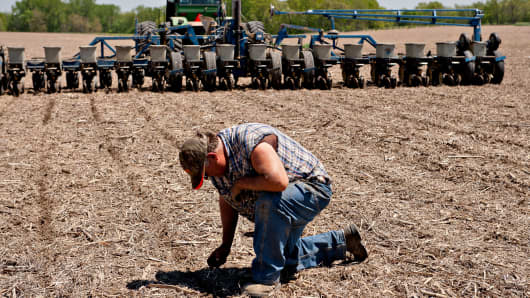What's setting off alarms is a possible downward spiral in farm land values—coupled with an expected decrease in income—that could raise farm debt to unsustainable levels.
A report released last month by the Federal Reserve Bank of Kansas City warns that if farmers use their accumulated wealth instead of profits to finance their agricultural investments, they could end up in greater debt, risk bankruptcies and potentially face the loss of their farms.
There's precedent for such a boom-to-bust cycle based on rising debt. Farmers suffered downturns in the 1920s and 1980s following economic booms in the 1910s and 1970s. In both cases, rising debt left many bankrupt.
(Read More: Fears Over Economic Boom to Bust for Farmers)
"I remember the 80s, and it was a bad time," said Schriver. "Land values went south, and a lot of farmers were in debt. There were a lot of bankruptcies from overdue loans that couldn't be paid."
The value of their land is an economic linchpin for farmers. Farmland accounts for 85 percent of the typical farmer's assets and serves as collateral for many loans. If land prices fall, so could the value of farms themselves. Investments in farmland have had three years of double-digit growth, according to the Federal Reserve study, as farmers keep putting money into land instead of other investments, such as stocks.
"Land values can't stay as high as they are now," said Hurst, who's written on the subject. "They've increased at a double-digit rate for the last seven years in the Corn Belt. But those values can crash in a hurry, increasing debt levels. Just look at former home owners in Las Vegas and Southern California."
"We can see debt already increasing," Hurst said. "A Kansas Farm Management Association report says that the number of farmers with a 40 percent debt ratio is higher now than it was in 1979," and that there are three times as many farms with a debt ratio of more than 70 percent, he added.
A rise in interest rates also could make farm debt worse, said Roger Hadley, a 60-year-old farmer.
"I think there's a false sense of normalcy with farmers about this right now," said Hadley, who grows soybeans and corn on 700 acres near Fort Wayne, Ind.
(Read More: Bad News at the Grill as Beef Prices Hit All-Time High)
"Rates have been low for a while, but if they do go up, that's only going to increase the debt burden on farmers," Hadley said. "Loans would get more expensive."
What happens to interest rates and land values may be a guessing game at this point. But it does seem fairly certain that farm incomes are headed down. The Department of Agriculture predicts a 25 percent decline in farm profits next year as commodity prices level off and exports are reduced.
This comes after incomes reached $98.1 billion last year—topping an overall increase of 147 percent since 1988, according to the USDA.
"We're having a lot of commodity surplus here because the world is growing its own food," Schriver said. "And prices are going to go down as a result."
Lower farm income only adds to the pain of increasing costs.
"Not too long ago it took $400 to grow an acre of corn," Schriver said. "Now it's $1,000. A bag of seed was around $35 to $40 an acre. Now it's $245 or more. It's getting very expensive to farm."





